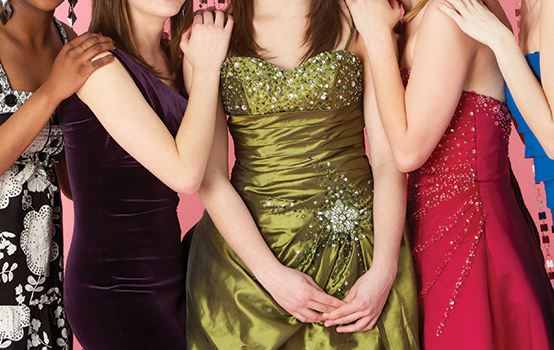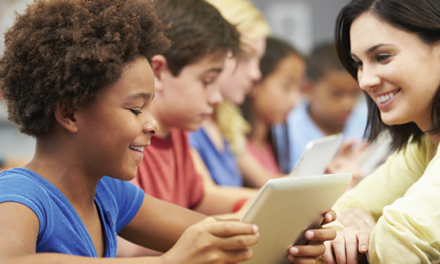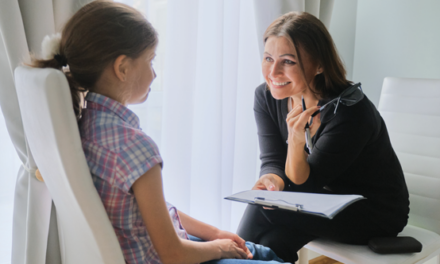 A unique high school English class links classroom learning with real-life applications and enables students to learn more about others with disabilities and about themselves.
A unique high school English class links classroom learning with real-life applications and enables students to learn more about others with disabilities and about themselves.
It’s prom night. A big night for most seniors, but not for one. Elizabeth sits at a table, radiant in her elegant red gown, hair carefully coiffed, nails manicured and sparkling. She silently takes in the sights and sounds of the night with her date — her adult special education paraprofessional. Sitting alone isn’t anything new to her. Elizabeth has autism.
At another table, Kim sits with a group of friends. She notices Elizabeth sitting alone with an adult. What a crappy way to spend prom night, she thought. Kim has seen Elizabeth around school, but has never spoken to her. As part of one of her English classes, Kim has been mentoring an elementary student who is also on the autism spectrum and has seen how painful it is for her to be so isolated from others her age. Without a word to her friends, Kim rises from her table and slowly approaches the two quietly sipping their Cokes.
“Hey,” she begins cautiously, “do you wanna join me and my friends?”
Elizabeth can scarcely believe what she is hearing. Her paraprofessional is equally astonished. An invitation like this is downright rare — and special. Elizabeth nods and follows Kim back to a table of giggling girls.
The next morning, Kim excitedly texts two teachers, “I had the BEST time at prom! Ur never gonna believe what happened. Gotta tell u bout it! ttyl.” In class, Kim explained what happened, adding, “We danced with Elizabeth all night! I never would have done that before I took your class.”
This is just one of an array of special moments that have occurred since we developed a unique English course at Model High School in suburban Detroit. Parents of special needs students in the Bloomfield Hills district had long sought ways to create a more tolerant school community for their children — as well as opportunities for them to socially interact with their general education peers. While many special needs children were often mainstreamed into general education classrooms, quality interaction between special education and general education students was unfortunately uncommon.
Literature for social connections
We set out to address these discrepancies. We are two professional educators with distinct educational expertise. Wendy Olah is a social worker with extensive knowledge about and experience with special needs students; Kathleen Conklin is an English teacher well versed in instructional methodology, assessment, and classroom management. Both sets of knowledge were essential to the successful creation of an elective English course we named Literature for Social Connections.
One major focus of the course was to teach high school students about disabilities in order to increase their knowledge and understanding. However, equally important was creating opportunities for actual interaction with special needs students. As a result, we decided to train students to be peer mentors. For one to two class periods per week, students would work in mainstreamed or self-contained elementary, middle school, and high school classrooms, some with children on the autism spectrum, and some with students who were physically, emotionally, or cognitively impaired.
When educators have the courage to step aside and let students control their learning, magic can happen.
Model High School was the perfect “science lab” for this experiment. Consisting of only seven teachers, Model functions as a part-time program in the district; students at Bloomfield Hills High School may elect to take anywhere from one to six of their seven classes at Model High. Class size is typically 18 to 20 students, and classes are designed to individualize education. We emphasize personal connections and reciprocal relationships between staff and students, meaningful curriculum, and independent learning — often designed by students — that is relevant and lifelong in nature. Model was the perfect place to offer a course that asked students to take a distinctly active role in their learning and move outside their educational and emotional comfort zones.
Redefine roles and relationships
Much of what we do at Model High School stems from our belief that students must play an increasingly active role in their education. We are convinced that the most powerful learning takes place when we value students’ passions, voices, and choices in learning.
Ritchhart and colleagues have taught us that when we view teaching as “little more than the delivery of content,” that puts the focus on the teacher, not the learner and assumes that “learning is merely taking in what has been delivered” (2011, p. 25). They argue that putting the learner at the “hub of the educational experience” (p. 26) profoundly affects what happens in the classroom. That allows teachers to facilitate learning rather than deliver learning. We wanted to ensure that our classroom activities were less about finishing a teacher-developed task that held little meaning for students and centered more around a “true development of understanding” (p. 9).
Since “learning is a product of thinking,” Ritchhart and colleagues say teachers must structure lessons that ask students to scrutinize, wrestle with, and explore ideas rather than sift through them in what they call “tell and practice” (2011, p. 9). They remind us that “when thinking is missing, learning is missing” (p. 10).
As we designed our course, we redesigned the roles of teacher and student. We collaborated to develop the most effective ways to help students develop an understanding of disability. Each instructor had clearly defined roles. Beyond these first few weeks of foundational instruction, Olah met with each student to determine the best mentoring placement in a K-12 classroom in the district. Olah’s expertise was essential when students wrote in their journals about their joys, struggles, and questions. Students often requested outside meetings and reading material to learn more and develop effective strategies for future visits.
During their instructional classroom time at Model, Conklin not only worked on reading strategies, research and presentation skills, but strengthened students’ knowledge through related texts. Students studied the history of disability in the United States, examined relevant laws, and read texts in a variety of genres, including Tom Fields-Meyers’ book, Following Ezra: What One Father Learned About Gumby, Otters, Autism, and Love From His Extraordinary Son (NAL Trade, 2011).
Redefining the teacher-student relationship was equally imperative. In keeping with the spirit of the program at Model High School, we define ourselves as “facilitators” rather than “teachers” in order to emphasize the collaborative nature of the course and underscore the profound value of each student’s ideas, knowledge, and importance as a role model and teacher. Students had the cell phone number for each facilitator and knew they should text Conklin if they would be absent from any mentoring visits. We also invited students to contact either of us with problems or questions. Additionally, we paired students new to the class with experienced students who took them as interns to their mentoring visits, explained the class, shared experiences, answered questions, and worked with them to solve problems throughout the semester. Again, this changed the dynamic between teacher and students, as well as among students.
Authentic learning situations
Students became so engaged in the course — and intrinsically motivated — because they were expected to use what they learned in class in real-life situations. Often, the well-being of others depended on their ability to recall and apply their classroom learning in a new context, and they did not want to let their mentees down. The progression of relevant knowledge, scaffolded by instructors, and enriched by their mentoring experiences was key. Ritchhart and his colleagues explain that “to develop understanding of a subject area, one has to engage in authentic intellectual activity” (2011, p. 10). For us, that meant allowing students to assume responsibility, solve problems, make decisions, and develop new understandings. Because students had to use their knowledge, often in different ways every week — and frequently with students who needed their help — they became serious about the class, asked thoughtful questions, and went beyond expectations. Students had a “reason to think deeply” (p. 26), and we were continually surprised at students’ depth of understanding and how fluidly they applied that knowledge in their interactions with their mentees.
When educators have the courage to step aside and let students control their learning, magic can happen. In fact, students have been some of our best teachers. As we have watched and listened to almost 100 students over several semesters, we’ve learned many valuable lessons that we continue to apply to our practice.
Lesson #1. A student’s level of personal engagement with his learning is directly related to the depth of learning that occurs.
Students developed an understanding of disability that is impossible to garner from a book or discussion. Most initial journal entries revealed a level of nervousness about taking the course; many students said that before the class they were “afraid of kids with disabilities.” It wasn’t long before students’ views took a dramatic turn. After several classroom visits, one girl said, “Now I can say kids with autism are extremely special and amazing.” One girl remarked, “when I see my child, I do not see a kid with autism, I see a kid running around in gym having fun just like everyone else.”
Many students admitted, as one did in his journal, that they had “a lot of preconceived notions,” about disabilities. One mentioned that he “thought autism was synonymous with mental retardation. Nick showed me that was not the case. Nick is a very bright boy.” Another student gratefully observed that “many of [her] ignorant and prejudiced views have been altered.” One young man wrote in his journal that he “was able to really think what their lives were like and . . . imagine being in their shoes.” Over time, almost every student noted that they found themselves becoming “more patient, understanding, and comfortable around people with disabilities.”
Lesson #2. Empathy grows within the boundaries of personal relationship.
Not only did students begin to understand disability more intimately, they also began to develop empathy. One student noted that working with his peer student “has shown me how much the world can really take a toll on someone.” They began to realize that their mentees had “all the normal struggles of life, then [the] disability adds to it.” One student wrote that working with a student with disabilities “opened up not only my eyes, but my heart,” stating that her “patience and compassion is so much greater now that I realize these kids didn’t ask for this life.”
Lesson #3. Empathy for one can lead to empathy for many.
This empathy, however, transcended the classroom experience; numerous students noticed they had greater compassion for all people, not just the students that they had gotten to know personally. Many noted that they had become less judgmental, crediting the class for the change. One young woman wrote that her student “taught [her] to give people chances.” Another remarked, “I have become much more aware of how my actions and words affect other people.” One girl observed that the class “helped me become . . . more understanding . . . and so much more loving.”
The most powerful learning takes place when we value students’ passions, voices, and choices in learning.
These new realizations also affected many students’ relationships with family members. One young woman wrote that she “was able to go home and have more conversations with [her] parents and listen to what they had to say.” Another discussed her younger brother, who is on the autism spectrum, stating, “I learned to be more patient with my brother and . . . how his mind works. I never understood why he was so uptight . . . I wanted him to be like any other kid. This class showed me how he actually perceives the world.”
Lesson #4. Empathy often leads to action.
Their experience in the class also led students to become passionate advocates. Time and again, students told us they had “decided to continue learning about and working with children with special needs by volunteering” at various places around the metro Detroit area, including Friendship Circle, a nonprofit organization in southeastern Michigan that serves individuals with special needs, as well as their families. Several happily detailed that they were “able to now carry on full conversations with people and correct their wrongs about . . . autism.” A few wrote about challenging people who made remarks about people with disabilities. One mentioned that “not so long ago, I was with friends and they were throwing around the word ‘retarded.’ I got extremely mad . . . and told them how ignorant they sounded.” Before taking the class, he said he “didn’t truly understand how awful it was to . . . call someone a ‘retard’ without thinking about how much disrespect carries along with it.”
We were continually amazed that students passionately wanted others to understand disabilities the way they did. One young woman went so far as to take an independent study during her final semester in order to “[produce] a video to create awareness. . . . My goal was to show people at high schools, and all over the community, that kids with disabilities are just like us; they need to be treated without the judgment they get in our society.”
Lesson #5. When students learn about others, they often learn about themselves.
A predominant theme in journals was that the mentoring experiences were changing how our students viewed themselves. Many discovered character traits they didn’t know they had. One reported, “Every time I saw Ben, I felt as though I figured out more and more about who I truly was. I realized I am a nurturer and that I show much compassion to people that I make a healthy relationship with.” Another realized that the class “taught me life lessons and [made me] realize I never had anything to be afraid of.” For another, “overcoming my fear of doing something wrong with Nicola . . . was one of the biggest learning experiences of all. Those things will happen. . . . I will make mistakes. I will at one time or another have a lot asked of me, but I will always make the most of those experiences.”
Lesson #6. Personal, powerful learning experiences affect students’ lives.
For some, taking the course validated — or challenged — their decisions regarding college and career plans. One girl wrote that “the strong compassion that I have gained from mentoring and my determination to succeed will enable me to accomplish my goal of becoming a nurse.” Another was grateful that the class “reassured me that I DO want to be a special needs teacher when I’m older, and that it is something that I have a knack for.”
For others, it opened up an area of study they had not previously considered. And for a few, it completely changed the direction they would take. One young woman reported, “I had my mind set that I was going to major in business. This semester, it became apparent that this was the wrong career path. I decided I wanted to go pursue a career in special education. I knew instantly it was right for me.”
Ripple effects
The ripple effects of the class are not only touching but enduring and continue to affect our school and community in striking ways. One former student, currently a college junior, emailed us a link she thought current students should see; it was an “ABC News Special Report” about a girl with autism who learned to communicate at age 11. Hailey wrote, “A friend of mine showed me this link and I had to send it to you both immediately! I hope that Literature for Social Connections is still . . . offered to students. It had a profound impact on me and is such important work. If not or if there is anything I can do to assist the class, I would be more than willing to help!”
Earlier this semester, a special education teacher contacted us. One of our kindest and most hard-working students, Lauren, has been working in this teacher’s middle school classroom for over eight months with a boy who struggles with ADHD (Attention Deficit Hyperactivity Disorder). His mother told the classroom teacher that Lauren had gotten more out of her son than she could ever have imagined and was so grateful that she was wondering if she could hire Lauren to tutor him after school. Lauren’s eyes shone when we told her about this parent’s request — and how proud we were of her. Even before realizing she would be paid for the after-school tutoring, she nodded and replied, “Yes, I’d really like that.”
Every high school has students with special needs. And every high school has amazing young men and women who would make wonderful peer mentors for them. While Model High School is a unique program for which we are incredibly grateful, we believe this class could be successful in any school district. As long as the district is willing to fund a class taught by both a qualified classroom teacher and a special education professional (who could be a psychologist, resource room teacher, speech and language pathologist, etc.), this course could be implemented virtually anywhere.
We began this journey loaded with optimism, a great deal of trust in each other and our students, and willingness to see where our venture would lead. While we hoped students would enjoy the class, build their English skills, and do some much-needed good in the process, we were unprepared for the remarkable feedback we received.
Ritchhart and his colleagues at Harvard’s Project Zero claim that when “there is something important and worthwhile to think about and a reason to think deeply, our students experience the kind of learning that has a lasting impact and powerful influence” (2011, p. 26). When students are asked to think deeply, there is a greater possibility that they will also feel deeply. And that opens the door to the possibility — the hope — that someone will look across a room at another person, recognize her pain, and commit a Random Act of Kindness. Instead of remembering a night where she sat alone, Elizabeth remembers something unique: being included, being important, being seen. That night may have be a fleeting memory for Kim. But not for Elizabeth. For her, it was life changing. And in the end, perhaps that’s what is most important.
Reference
Ritchhart, R., Church, M., & Morrison, K. (2011). Making thinking visible: How to promote engagement, understanding, and independence for all learners. San Francisco, CA: Jossey-Bass.
CITATION: Conklin, K. & Olah, W. (2013). Getting to know you. Phi Delta Kappan, 95 (4), 59-63.
ABOUT THE AUTHORS

Kathleen Conklin
KATHLEEN CONKLIN is an English teacher at Model High School, Bloomfield Hills, Mich.

Wendy Olah
WENDY OLAH is a social worker at Model High School, Bloomfield Hills, Mich.










